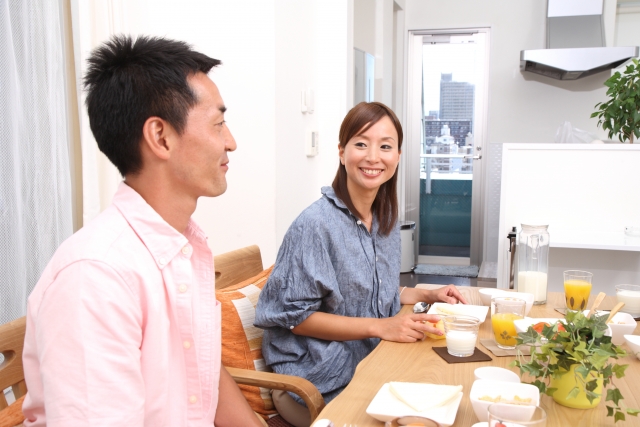Basic Japanese Table Manners You Should Know
Whenever you have dining experiences in other countries, it is always good to know their table manners so that you don’t look foolish or you don’t annoy people in the country.
Japan shares some common table manners and etiquette with other countries such as not putting your elbows on the table, but many of them are unique to Japan, sometimes what is considered to be rude in your country is correct table manners in Japan and vice versa.
But don’t be too nervous. Japanese people understand you are not familiar with Japanese manners even if you make mistakes. But eating food properly makes you look polite and well-mannered. Today we introduce you to basic Japanese table manners including how to use chopstick correctly and how to eat a certain type of dish correctly.
Japanese table manners: Before Eating
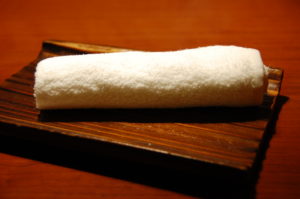
Before eating, it is important to say ”いただきます”(Itadaki masu). It literally means “I will eat this food” in a formal way, but it is a way to show your gratitude for the food, those who cultivated the ingredients, those who cooked it, and the fact that you can fill your stomach and provide nutrition for your body. Starting the meal without this phrase is considered to be impolite.
For more about the Japanese phrases you will use in restaurants, check here.
At most restaurants in Japan, wet towels (oshibori) are provided to wipe your hands. Remember that you shouldn’t wipe your neck or face with oshibori! Also, you shouldn’t use it to wipe table even if something is spilled. Use paper napkins provided on each table or call a server to bring you a towel.
Japanese table manners: While Eating
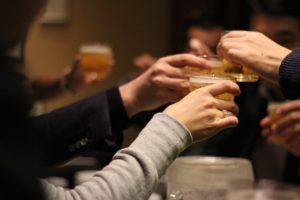
How you eat shows how much you know about table manners, right? Here are important Japanese table manners you want to keep in mind while eating including how to eat chopsticks properly.
-Wait until others’ food arrives
Even if your food has arrived, please wait until the others’ get their food. Sometimes the others say “お先にどうぞ” (Osakini douzo; please go ahead). In this case, you can start eating, but make sure to say “お先にいただきます”(Osakini itadaki masu). This phrase means “I humbly eat before you all,” indicating that you appreciate their consideration for letting you eat first.
-Drinking manners
Make sure to start drinking after everyone got the drink and saying a drinking salute, “かんぱい!”(Kampai!; Cheers!), especially at drinking parties and when you drink with someone older than you.
Another important thing is serving each other’s glasses when drinking alcoholic beverages rather than pouring by yourself. Check your friends’ glasses at times, and refill the drinks if their glasses are getting empty. It is considered to be better to refill before the glass gets completely empty. Likewise, even if you finish your drink, please wait until someone serves the drink. Don’t worry; most people are checking your glass and offer to pour the drink.
In drinking parties, it is polite to drink the alcoholic beverages at least one sip even if you cannot drink much. If you cannot handle the liquor, excuse yourself to the others that you are lightweight.
-Use chopsticks properly
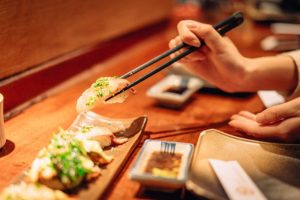
There is nothing confusing in Japanese table manners than using chopsticks properly.
In most restaurants, disposable wooden chopsticks are provided. Most disposable chopsticks come in a paper envelop-like case. First, take out the chopsticks out of the case and hold the chopsticks horizontally to pull them apart. Make sure not to hold them vertically to split them apart: otherwise, you may hit others sitting next to you.
Also, whenever you rest the chopsticks, place them on a chopsticks rest; not on the dish. If the chopsticks rest is not provided, make it with the paper case or place the sticks on a paper napkin.
Some Don’ts about using chopsticks
*Don’t place your chopsticks vertically in a bowl of rice or other food
Leaving your chopsticks standing in a bowl of rice or other dishes is a practice done when Japanese people visit ancestors’ graves. Doing the same behavior in daily dining is considered to be impolite, or even considered to be offensive to some people.
*Don’t receive the food with chopsticks
There may be times your friends pass you the food with chopsticks. Please don’t receive it with chopsticks. It resembles a ritual in funerals. In the crematorium, bones are picked from the ashes and passed around by using chopsticks from one member of the family to another in order to transfer it to an urn. If you do this when eating a meal, some people associate it with the funeral and feel uncomfortable. If your friends offer the food, take it with your individual plate.
*Don’t skewer the food with chopsticks
Even if you cannot control chopsticks well, don’t use them like a skewer. If you cannot get hold of chopsticks, ask for a fork and knife, or a spoon.
*Don’t lick or nibble empty chopsticks
You may mind a bit of sauce or rice stuck to your chopsticks, and you want to clean it. But don’t remove it by licking or nibbling them: instead, please use a paper napkin or kaishi, which is usually provided at high-end restaurants. Also, don’t hold chopsticks in your mouth. Licking or sucking chopsticks make you look poorly mannered and childish.
*Don’t move a dish with chopsticks
You probably think chopsticks useful to pull a dish towards you or put it aside. But, don’t use chopsticks as a device to move the dishes. If you want a dish that is a bit away from you, ask friends to pass it to you.
*Don’t play with chopsticks
Like playing with forks and knives is considered to be bad in the Western countries, playing with chopsticks is not good manners. You may have seen people beating a dish with chopsticks like they were playing an instrument, it is no good manners.
-Separate the food into the one-bite size with chopsticks
When you eat something that you cannot eat in one bite, break it into the one-bite size with chopsticks. Position your chopsticks so one stick is on the upper side of the food and the other stick is on the downside. Then, move the upper side of the stick like you are pressing the food with it. It is said that most Japanese restaurants serve dishes soft enough to separate with chopsticks. In the case they serve items firm enough to do it, you don’t have to split them into small pieces. But try to finish within two or three bites.
It is important to remember that even if you cannot separate the food with chopsticks, you shouldn’t use them like a fork and knife.
-Hold a dish
In most countries, holding a dish when eating is considered to be rude.The opposite applies to Japanese table manners: when eating from a small dish, holding it with one hand is good manners. But a large dish shouldn’t be picked up.
-Finish all of your food
Try to finish all of your food. Leaving the food is considered to be impolite because it is not only rude for the chef but also wasting the food. This dining etiquette is originated from the time when Japan was lack of food during and after the WW2. This is what people say: “Don’t leave even the last piece of rice!”
How to Eat…
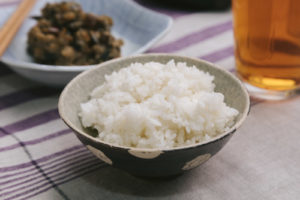
-Rice
Hold the rice in one hand and lead it towards your mouth. If it comes with the lit, place it on the left side of the rice bowl with the inside of the lit up. Don’t pour soy sauce on the rice directly.
-Miso soup
Hold the bowl and drink the soup directly. If there are large pieces of ingredients, it is good to drink the soup with holding them with chopsticks. Usually, miso soup comes with the lit. Make sure to place it on the right side of the miso soup bowl.
-Noodles
You don’t have to hold up the bowl, but be sure to place your hand (which you don’t hold chopsticks with) on it. Pick up noodles with chopsticks and lead them to your mouth. You may wonder if you should make the slurping sound just like the Japanese do. You don’t have to make that sound if you can’t or don’t want to, but it is considered to be a compliment for the chef to eat noodles with the slurping sound.
To try some soup, use a big spoon either accompanying the noodle or provided on your table. If you don’t have the spoon, you can drink the soup directly from the bowl.
-Sushi
As written in detail in this article, first, pour soy sauce on a small dish provided. Hold sushi either your hand or chopsticks, so the ingredient faces downward, and dip it in the sauce. Make sure not to pour the sauce directly on sushi or not to put too much sauce.
-Sashimi
As you did for sushi, pour soy sauce on a small dish. Put some wasabi on sashimi and dip it in the sauce. Don’t put wasabi on the sauce. Likewise, you shouldn’t pour the sauce directly over sashimi.
-Skewered dishes
In the formal dining, it is polite to remove the items from the skewers with chopsticks.
Japanese table manners: After Eating
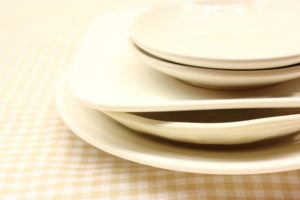
After you finish your meal, be sure to say “ごちそうさまでした。”(Gochisousama deshita.). It literally means “It was a great meal,” but by saying it, you show the gratitude for the food and those who were involved in all the process until the food was served at the table. You can also say it when leaving the restaurant, telling the servers that you enjoyed the meal and appreciated their services.
If you keep these manners in mind, you won’t embarrass yourself at restaurants or when you are dining out with Japanese companions. We hope this information will help you out!
